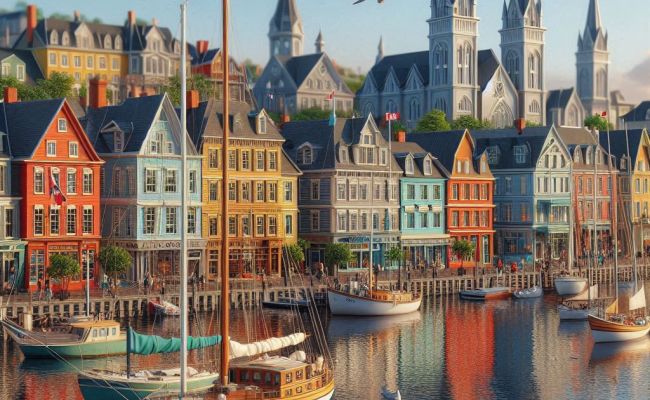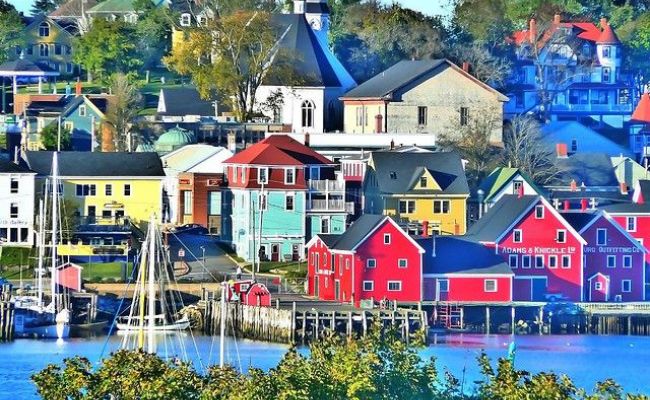Founded in 1753 as part of the early British efforts to create Protestant towns in the area, Lunenburg is located on Nova Scotia’s South Shore, Canada. Initially reliant on offshore fishing, the town has grown to house Canada’s largest secondary fish processing facility today. Its late-nineteenth-century commercial boom produced a legacy of well-preserved historic buildings that reflect its marine background.
Lunenburg designated a UNESCO World Heritage Site in 1995, is known for its well-preserved British colonial pattern and Indigenous wooden buildings from the 1800s. This designation emphasizes its significance as a cultural and historical treasure, especially when traditional sectors such as Atlantic fishing face uncertain prospects. Furthermore, Lunenburg is designated as a Canadian National Historic Site, which protects its historic core and ensures its continued cultural relevance.
History
Lunenburg has a long and turbulent history, beginning with Mi’kmaq colonies and peaceful coexistence with Acadian French immigrants in the 1600s. The British administration established key forts, such as Fort George, to protect against battles with indigenous and French soldiers. In 1753, the British colonized the area with European Protestant settlers, encountering difficulties and periodic rebellions due to discontent and abuse. Following the Acadians’ eviction in 1755, New England Planters repopulated Lunenburg, braving incursions during battles such as the American Revolution and the War of 1812. The town thrived in the shipbuilding and fishing industries, featuring noteworthy ships like the Bluenose, despite changes in maritime operations and prohibition-era rum-running. Lunenburg’s legacy lives on through cultural exports such as the Lunenburg Cure and its shipbuilding heritage.

Old Town Lunenburg
The original planned arrangement on a high, south-facing hill distinguishes Old Town Lunenburg in Nova Scotia, a UNESCO World Heritage Site since 1995. Founded in 1753, the town showcased its European background and marine role through a compact grid design of narrow streets. Today, it includes the old harbor and over 40 historic structures designated on the Canadian Register of Historic Places.
Key sites include the Knaut-Rhuland House (1793), which is now a museum; Zion Evangelical Lutheran Church (1890), a significant wooden church; and St. John’s Anglican Church (1763), which is known for its Carpenter Gothic architecture. The Lunenburg Opera House (1909), despite not being on the registry, contributes to the area’s cultural fabric.
Nova Scotia purchased 17 waterfront buildings, previously held by Clearwater Foods, in 2005 to ensure their preservation. The Lunenburg Waterfront Association now manages these assets. The area also benefited from a $1.5 million shipbuilding infrastructure update during the Bluenose II restoration project, which began in 2010.
The former Smith & Rhuland shipyard is now a recreational marina. The Fisheries Museum of the Atlantic, part of the Nova Scotia Museum, houses a variety of vessels, including the well-known Bluenose II. Commercial operations along the shoreline include ABCO Industries, which manufactures aluminum vessels, and Lunenburg Shipyard, which provides dry dock services, manufacturing, and foundry capabilities, are examples of commercial operations along the shoreline.
Old Town Lunenburg therefore mixes historical preservation with modern maritime activity, highlighting its rich cultural legacy and continued economic vitality.
New Town Lunenburg
Lunenburg prospered throughout the 1800s thanks to shipping, trade, fishing, farming, and shipbuilding, and it expanded beyond its original bounds. Lunenburg expanded its settlement to the east and west of the old settlement, forming what is now known as the new town. This area contains approximately a dozen structures on the Canadian Register of Historic Places.
Integrity
The 33.85-hectare site contains all of the features required to reflect Old Town Lunenburg’s Outstanding Universal Value. The site completely preserves the historic town design, except for the fortifications that ringed the town in its early years and have no surviving above-ground relics. Its boundaries provide an adequate portrayal of the elements and processes that reflect the property’s value, and there is a 32.44-ha buffer zone. The property does not suffer unduly from the consequences of development and/or neglect.
Climate
Because of its seaside location, Lunenburg’s climate is moderate, which limits temperature extremes. This means that it is slightly milder in the winter and slightly cooler in the summer than most other regions with similar latitudes. Lunenburg has pleasant, breezy summers with temperatures ranging from low to mid-20s °C (70s °F). It is rarely hot and humid. Winters are cold and often damp. Heavy winter snowfall can occur, but Lunenburg’s snowpack is often short-lived due to frequent winter showers and freeze-thaw cycles. Thick fog and moist conditions can occur at any time of year, but particularly in the spring. Cooler ocean temperatures cause a seasonal lag, causing spring to arrive in Lunenburg late in the season, often not until mid-May. Overall, Lunenburg experiences heavy precipitation from November to May, with the warmest and driest months being July, August, and September. Fall is usually bright, clear, and cold. January: 1°; February: 2° Mar: 5° Apr: 11° May: 15° June 21°, July 23°, August 24°, September 21°, and October 15°. November: 9°; December: 4°
FAQ
Why is Lunenburg famous?
Lunenburg is the best surviving example of a planned British colonial settlement in North America. Established in 1753, it has retained its original layout and overall appearance, based on a rectangular grid pattern drawn up in the home country.
Why is Lunenburg so colorful?
Ship captains painted their homes the same color as their ships, which made the ships easier to identify as they sailed into their homeport
Which country is Lunenburg?
Lunenburg /ˈluːnənbɜːrɡ/ is a port town on the South Shore of Nova Scotia, Canada.
